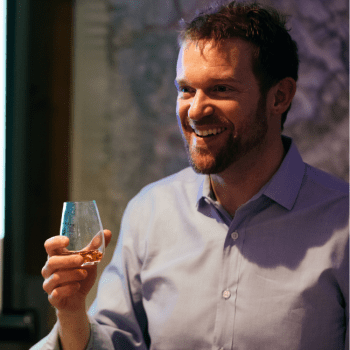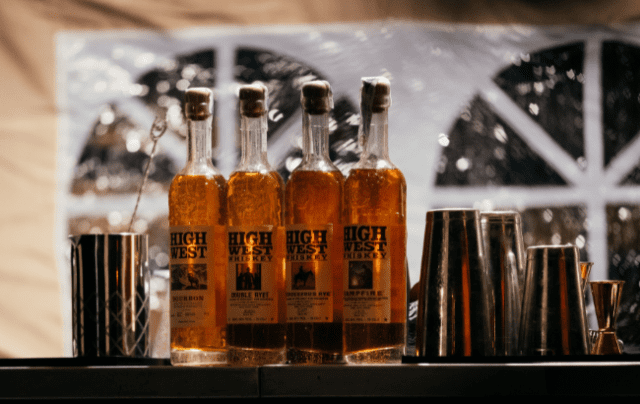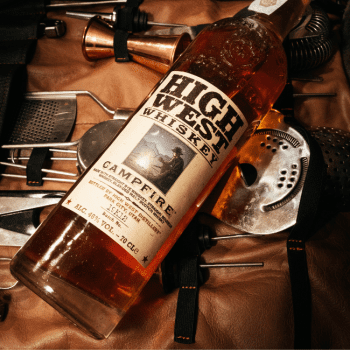SB meets… Brendan Coyle, High West
In a chalet at the foot of the French Alps in Chamonix, we spoke to Brendan Coyle, master distiller at Park City-based distillery High West, to better understand the brand’s connection to the mountains – and talk about American whiskey, of course.

Tell us about your background and what inspired High West?
I started in the beer-brewing industry around 2003. It was as an apprentice brewer at Red Rock Brewing Company in Salt Lake City and I worked underneath Kevin Templin. He was (and still is) a phenomenal brewer. He taught me an incredible amount and brought me into the industry.
With High West, we started in 2006 and the idea was to create an innovative American whiskey brand. When you think of where we are located – in Utah – it’s not necessarily the first place you think of with an American whiskey, right? Well, we really wanted to put together a wonderful whiskey brand in a beautiful place in the United States, and Utah is one of those places.
How has the company evolved over the years?
We made our name in rye whiskey, but it’s always been about American whiskey. When we released Rendezvous Rye we garnered a lot of notice, and so from the very beginning we were kind of known as this rye whiskey distillery from the mountains of Utah. For a long time I was producing a lot of rye whiskey, just running to catch up basically because you got to be popular with rye whiskey. However, the goal was always to be an American whiskey brand, not a rye whiskey brand, and I feel like we are well on our way to being recognised as that.
Our Bourbon programme is in full swing and our American single malt has been launched for five years now. At first it was a bit of a tough sell – people didn’t really know much about our production because it hadn’t been worked into our blends yet. So in the early days there was a lot of education. Now consumers are really seeing it come to fruition.
Explain the Double Rye, how happy are you with its growth?
So with the Double Rye, we focus on showcasing distillate character and the distillate quality of what we do: we’re big fermentation lovers. We love showcasing how the grains, yeast strains, fermentation science and all those things can play together to bring out the flavour. That’s not the whole story of the Double Rye, but it’s part of the story (and we love talking about that part of the story).
Double Rye is all about focusing on the great spice profile of well made, high-rye whiskey. Spices such as cinnamon, clove and ginger, and herbal characters like mint, rosemary and juniper. The goal was to showcase the spiciest rye whiskey in the world. I also love reminding people that Double Rye is a celebration of young rye whiskey, and that’s a big reason why you have such a wonderful spice and herbal profile in Double Rye, because that character comes from the distillate, not the barrel ageing process. As you age it further, the fresh lively spice profile diminishes with the increase of caramels and vanilla in the maturation process, so it’s all about finding the right balance and allowing the bright spice to shine.
Bourbon is something like 16 to one in the US market, so that owns the roost when it comes to volume, but we’re pretty enthusiastic with rye. It seems as though the international markets are starting to really turn to rye as well. Australia is our biggest export market and that’s pretty recent, in the last 18 months or so. I was down there five or six months ago and it’s been really well received. What I notice when I travel internationally – and I do a bunch now – I think the international market is waking up to see ‘oh, there’s more out there than Jack [Daniel’s] and Jim [Beam]’.

How are you feeling about the new American single malt regulations and do whiskey rules allow for enough experimentation?
Look, I’ve been making American single malt for nine years, maybe eight years now… it’s been a while. I like standards. I like bodies to call out a standard on what you’re doing, but I also don’t want the regulation to be too strict there. We get into this kind of debate where it’s like ‘you know, should it be from one single distillery or one DSP (distilled spirits plant), and things like that’. My point is: I don’t want us to have the same regulations as Scotland. I think that’s very important, right?
We’re Americans, we do stuff differently and we like to innovate. I think that if we just made the same basic regulations as Scotland, we’d be missing an opportunity – how to stand out, how to be different, how to innovate. I think that’s a really interesting opportunity for us. I think it’s really important for us to stand out and be a little different.
And so my pushback and my resistance towards some definitions of the American single malt category are mainly because I wanted us to be different and stand out. Is the current definition a hindrance to us? I wouldn’t say it’s a hindrance and I wouldn’t say it impacted us too much. One thing I will say, though, is that I will always push to expand regulation a little more to allow for a little more innovation – because I think innovation is critical for America. That’s how America was built – on innovation.
What are you working on at the moment?
We’ve brought back the Campfire and made it all year round – before that it was a seasonal offering. We also launched Bottled-in-Bond, which is a quality stamp of approval (so to speak) from the federal government that’s actually quite ancient. It’s come back into fashion nowadays. It’s basically a 100 proof whiskey that’s a minimum of four years old, and it’s all distilled in one single season (six months) and from one single distillery.

Any future releases that we can look forward to?
Well, we do a bunch of different wine cask finishes and we have done for a long time. A Midwinter Night’s Dram is a good example of that – a ruby and tawny-Port finish of Rendezvous Rye, which got a cult following. So recently, we’ve done something with Prisoners Share wine out of Napa in California.
Then there’s also a Tequila-finish rye in the pipeline. That’s a project with Casa Noble. It’s a rye blend finished in Casa Noble Tequila cask barrels and it’s really about showing the interplay between rye and Tequila spice, which, when done correctly, is this really interesting complementary kind of blend. You won’t see that until 2025 at the earliest though.
What growth potential are you seeing in American whiskey?
American Single Malt is a category that’s growing and that we are excited to play a role in defining the flavour profile. And it’s in its infancy right now. It’s very, very young. However, over the last couple of years, what has caught my focus is what I think rye can be in the global market. I think that’s really interesting. I think of American whiskey in the global market, yeah, but I think American rye whiskey in the global market is just that much more interesting.
With a big heritage spirit, with a big sort of spicy profile and with it being more unique – and with American whiskey becoming much more popular on the international scene right now – I think American rye could really command some massive growth in the next 15-20 years on the global market. And I really think we can be a major player in rye when it becomes a serious deal on that global spectrum.
Related news
Cocktail stories: Speed Bump, Byrdi
